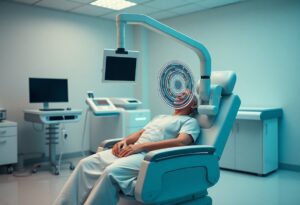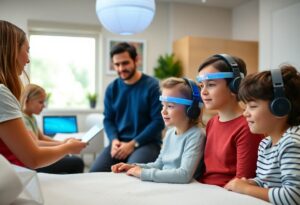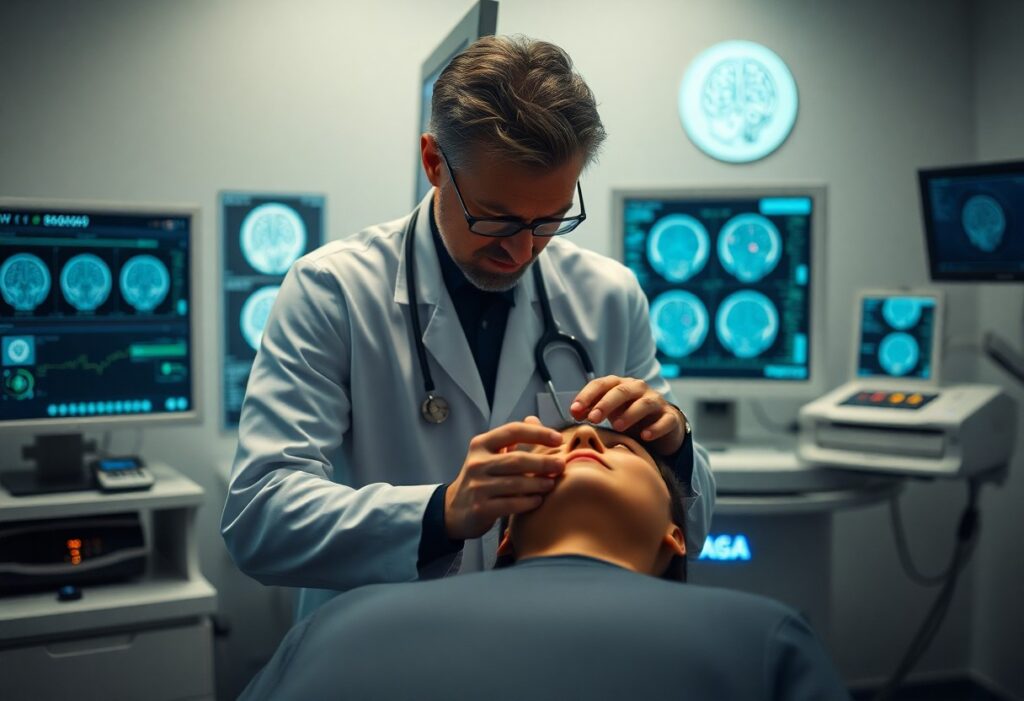Many individuals seeking recovery from stroke often explore various therapeutic options, and Transcranial Magnetic Stimulation (TMS) is a promising method. This non-invasive treatment uses magnetic fields to stimulate nerve cells in your brain, promoting healing and recovery after a stroke. In this blog post, you will learn how TMS works, its mechanisms of action, and the potential benefits it offers for enhancing brain function and cognitive performance in stroke recovery. Understanding the science behind TMS can empower you as you navigate your healing journey.

Key Takeaways:
- TMS Mechanism: Transcranial Magnetic Stimulation (TMS) works by using magnetic fields to stimulate nerve cells in the brain, enhancing neuroplasticity.
- Stroke Recovery: TMS has shown promising results in improving motor function and cognitive abilities in stroke survivors, aiding their rehabilitation process.
- Safety and Efficacy: Clinical studies indicate that TMS is a safe and effective intervention, with minimal side effects, making it a valuable tool in brain healing.
Understanding Stroke
Before venturing into the intricacies of TMS for stroke recovery, it’s necessary to understand what a stroke is and how it affects the brain.
Definition of Stroke
Stroke is a medical condition that occurs when the blood supply to a part of your brain is interrupted or reduced, preventing brain tissue from getting oxygen and nutrients. This results in the death of brain cells and can lead to severe physical and cognitive impairments.
Types of Stroke
There are primarily two types of strokes: ischemic and hemorrhagic. Both affect your brain but do so in different ways.
- Ischemic stroke: Occurs when a blood vessel supplying blood to your brain is obstructed.
- Hemorrhagic stroke: Happens when a weakened blood vessel ruptures, leading to bleeding in the surrounding tissues.
- Transient Ischemic Attack (TIA): Often called a mini-stroke, TIA is temporary and doesn’t cause permanent damage.
- Cryptogenic stroke: This type has no clear source of origin after extensive testing.
- Brain stem stroke: Affects the brain stem, impacting both sides of your body and potentially leading to locked-in syndrome.
After knowing the different types of stroke, you can better understand their implications and the importance of timely intervention.
| Type of Stroke | Description |
|---|---|
| Ischemic Stroke | Blocked blood vessel causing restricted blood flow. |
| Hemorrhagic Stroke | Bleeding in or around the brain due to ruptured vessels. |
| Transient Ischemic Attack (TIA) | Temporary symptoms indicating an impending stroke. |
| Cryptogenic Stroke | Stroke with no identified cause after testing. |
| Brain Stem Stroke | Affects crucial functions like breathing and heart rate. |
To fully grasp the impact of strokes on your health, consider how they may affect your mobility, speech, and ability to perform daily activities.
Symptoms and Diagnosis
Around 795,000 people in the United States experience a stroke each year, with symptoms including sudden numbness, confusion, difficulty speaking, and vision problems. Recognizing these signs promptly is necessary for effective diagnosis and treatment.
Another important aspect of understanding stroke is diagnosing it quickly through imaging tests like CT scans or MRIs. These tests help determine the type and extent of stroke and guide your treatment options. Additionally, neurological exams may follow, assessing your strength, coordination, and reflexes.
The Brain: Structure and Function
Now, understanding the brain’s structure and function is crucial for grasping how transcranial magnetic stimulation (TMS) can aid in stroke recovery and brain healing. Current evidence on transcranial magnetic stimulation and its effects can be found here. The brain is a complex organ with distinct regions, each dedicated to various processes that govern your thoughts, movements, and emotions.
Overview of Brain Anatomy
An overview of brain anatomy reveals that it consists of several key parts, including the cerebrum, cerebellum, and brainstem. The cerebrum is involved in higher cognitive functions and voluntary movements, while the cerebellum coordinates balance and fine motor skills. The brainstem controls crucial life-sustaining functions such as breathing and heart rate.
Neural Pathways and Neurotransmitters
Function plays a significant role in how neural pathways and neurotransmitters work together to transmit signals between different brain regions, enabling communication throughout your body. This intricate network allows you to perceive sensations, respond to your environment, and orchestrate complex behaviors.
It is crucial to understand that these neural pathways can be affected by strokes, which disrupt the normal flow of information within your brain. Neurotransmitters, the chemicals responsible for transmitting signals across synapses, also change in concentration following a stroke, altering how your brain communicates. This disruption affects your cognitive and physical capabilities, emphasizing the importance of targeted recovery strategies like TMS.
The Role of Brain Plasticity in Recovery
Neurotransmitters play a significant part in brain plasticity, the brain’s ability to reorganize itself and form new neural connections after injury. This adaptability enables your brain to compensate for lost functions and adapt to new conditions, highlighting its remarkable potential during the recovery process.
Brain plasticity is vital for your recovery journey, as it allows your brain to reestablish connections and learn new ways to perform tasks. The process is facilitated by TMS, which can stimulate areas of the brain, promoting neural growth and enhancing your ability to recover lost functions. By harnessing the potential of plasticity, you can improve your overall rehabilitation outcomes.
Transcranial Magnetic Stimulation (TMS)
Once again, you are likely seeking effective methods for enhancing stroke recovery and brain healing. Transcranial Magnetic Stimulation (TMS) presents promising avenues in this realm, leveraging neuroscience to encourage brain regenerative processes.
What is TMS?
An innovative non-invasive therapy, TMS uses magnetic fields to stimulate nerve cells in the brain. This innovative approach is designed to enhance neuronal activity and promote recovery in patients who have experienced strokes or other neurological impairments.
Mechanism of Action
Besides its non-invasive nature, TMS operates through localized magnetic stimulation, which induces electrical currents in targeted areas of the brain. This process can modulate synaptic plasticity, thereby fostering recovery mechanisms post-stroke.
Considering the effectiveness of TMS, it has been found to support neuroplasticity, allowing your brain to adapt and reorganize after injury. By activating specific brain regions, TMS enhances connectivity and function, which can contribute significantly to overall rehabilitation. The process involves carefully calibrated pulses delivered to predefined locations, leading to desired therapeutic outcomes.
Types of TMS
Excitability of neuronal pathways can vary, which is why several types of TMS are employed to address individual needs. Here are some notable types of TMS:
- Repetitive TMS (rTMS)
- Single-pulse TMS
- Deep TMS (dTMS)
- Theta burst stimulation (TBS)
- Maintenance TMS
Perceiving these differences allows you to understand which type may be most suitable for your specific condition. Importantly, the nuances of each method can enhance therapeutic interventions.
| Type of TMS | Description |
| Repetitive TMS (rTMS) | Involves repetitive magnetic pulses to stimulate the brain over a period. |
| Single-pulse TMS | Delivers a single magnetic pulse, often for mapping brain function. |
| Deep TMS (dTMS) | Penetrates deeper brain structures and targets more extensive areas. |
| Theta burst stimulation (TBS) | Utilizes brief bursts of TMS to improve efficiency and efficacy. |
| Maintenance TMS | Focuses on sustaining the therapeutic effects of previous treatments. |
And understanding these methodologies, you can engage in discussions with your healthcare provider about the most appropriate options for your recovery journey. Each type offers unique advantages that may align with specific therapeutic goals.
Perceiving the breadth of TMS applications can empower you in your recovery process, ensuring a well-informed approach to neurorehabilitation.
The Use of TMS in Stroke Recovery
Keep in mind that Transcranial Magnetic Stimulation (TMS) has become an impactful tool in your journey towards stroke recovery. This non-invasive technique stimulates specific brain regions, promoting neuroplasticity and potentially enhancing functional outcomes. Research indicates positive outcomes from TMS interventions, with findings demonstrated in studies such as the Effects of high- and low-frequency repetitive transcranial … that explore varying TMS protocols based on individual needs.
Clinical Applications of TMS
About the clinical applications of TMS, it has shown promise in improving motor function, language skills, and cognitive abilities in stroke patients. Hospitals and rehabilitation centers are increasingly integrating TMS into their treatment protocols to address the diverse challenges faced during recovery.
Efficacy of TMS in Stroke Rehabilitation
Recovery from stroke is often met with numerous challenges, but TMS demonstrates effectiveness in enhancing rehabilitation outcomes. Studies show that patients receiving TMS alongside traditional rehabilitative therapies experience greater improvements in motor function and quality of life compared to those receiving standard care alone.
A growing body of evidence supports the efficacy of TMS in stroke rehabilitation, emphasizing its role in neuroplasticity. As your brain adapts to injury, TMS can facilitate the reorganization of neural pathways, leading to improved movement patterns, better cognitive function, and overall enhanced recovery. The integration of TMS can thus be a vital component of a comprehensive rehabilitation strategy.
Individualization of TMS Treatment Protocols
Protocols for TMS treatment should be tailored specifically to your unique needs and recovery goals. Factors such as the type of stroke, timing of intervention, and individual response to treatment can influence the design of your TMS protocol.
Considering the individualization of TMS treatment protocols is necessary for maximizing its benefits. Each patient presents a different set of challenges following a stroke, and customizing TMS protocols can enhance efficacy. By assessing your specific needs, healthcare providers can adjust parameters such as stimulation frequency, location, and the duration of treatment, thereby optimizing the recovery process for you. Individualized TMS applications can contribute to a more effective rehabilitation experience, aligning with your specific recovery trajectories and goals.

Complementary Therapies for Stroke Recovery
All individuals recovering from a stroke can benefit from a comprehensive approach that includes complementary therapies alongside traditional medical treatments. These therapies can enhance your overall recovery process and support brain healing, offering a multifaceted strategy for regaining independence and improving quality of life.
Physiotherapy and Occupational Therapy
The combination of physiotherapy and occupational therapy plays a significant role in stroke recovery. Physiotherapy focuses on improving mobility, strength, and coordination, helping you regain physical functions. On the other hand, occupational therapy assists in relearning daily activities, enabling you to perform tasks that promote independence and enhance your quality of life.
Cognitive Rehabilitation Strategies
Along with physical recovery, cognitive rehabilitation strategies are imperative for addressing any cognitive impairments resulting from a stroke. This therapy aims to restore cognitive functions such as memory, attention, and problem-solving skills through tailored exercises and activities.
It is important to engage in cognitive rehabilitation as it helps retrain your brain to improve cognitive skills affected by the stroke. Techniques might include memory exercises, attention training, and strategy development, facilitating greater control over your cognitive processes and decision-making abilities as you rebuild your life post-stroke.
Nutrition and Lifestyle Modifications
Before focusing on recovery, it is vital to consider the impact of nutrition and lifestyle modifications on your overall health. A balanced diet rich in nutrients can support brain healing, while lifestyle changes such as regular exercise and stress management can have a positive influence on your recovery journey.
But adopting healthier lifestyle choices goes beyond diet; it encompasses maintaining a well-rounded routine that includes physical activity, community engagement, and mental health support. These adjustments promote not only better physical recovery but also enhance emotional resilience, ultimately contributing to your holistic recovery after a stroke.
Current Research and Future Directions
After exploring the foundations of Transcranial Magnetic Stimulation (TMS) in stroke recovery, it is vital to consider the ongoing advancements in this field. These developments not only enhance the effectiveness of TMS but also expand its applications in brain healing protocols.
Ongoing Clinical Trials
On multiple fronts, there are ongoing clinical trials aimed at assessing the efficacy of TMS in various stages of stroke recovery. These trials are critical for understanding how TMS can accelerate rehabilitation, improve cognitive function, and potentially enhance the quality of life for stroke survivors.
Innovations in TMS Technology
To improve its benefits, researchers are continuously innovating TMS technology. This includes developing protocols that enhance the precision and efficacy of stimulation, enabling tailored treatments that cater to your specific needs in recovery.
Research in this area is revealing sophisticated TMS techniques, such as theta-burst stimulation, which delivers bursts of magnetic pulses to stimulate brain activity in shorter treatment durations. These innovations not only increase the accessibility of TMS therapy but also open the door for combination with other therapeutic modalities, making your recovery process more efficient and effective.
Integration of TMS into Multidisciplinary Approaches
An increasing number of rehabilitation programs are integrating TMS into their multidisciplinary approaches. This collaboration between TMS practitioners and other healthcare professionals can provide you with a comprehensive care plan that addresses all aspects of your recovery journey.
Innovations in integrating TMS into wider rehabilitation strategies, such as physical therapy and occupational therapy, can significantly improve outcomes. By working alongside various specialists, you can benefit from a holistic approach that not only focuses on stimulating brain recovery but also on enhancing your physical and cognitive capabilities in a more synchronized manner.
Summing up
Drawing together the insights on TMS for stroke recovery and brain healing, you can appreciate how this innovative therapy harnesses the power of magnetic fields to stimulate brain regions associated with motor function and cognitive processes. By fostering neuroplasticity and enhancing your brain’s natural repair mechanisms, TMS provides a promising avenue for rehabilitation. As you explore your options for post-stroke recovery, consider how TMS may play a role in optimizing your healing journey and improving your quality of life.
FAQ
Q: What is TMS and how does it relate to stroke recovery?
A: Transcranial Magnetic Stimulation (TMS) is a non-invasive procedure that uses magnetic fields to stimulate nerve cells in the brain. In the context of stroke recovery, TMS is thought to promote neural plasticity—the brain’s ability to adapt and reorganize itself. By stimulating specific areas of the brain, TMS can help enhance motor function and facilitate recovery from the impairments caused by stroke.
Q: How does TMS contribute to brain healing after a stroke?
A: TMS contributes to brain healing by encouraging the growth of new neural connections and strengthening existing pathways. It can modulate brain activity in targeted regions, which may lead to improvements in cognitive functions and motor skills. This modulation can help counterbalance the effects of brain damage caused by a stroke, enabling patients to regain lost abilities over time.
Q: What types of brain functions can TMS improve in stroke survivors?
A: TMS has been shown to enhance various brain functions in stroke survivors, particularly in areas related to motor control, speech, and cognitive processes. Patients may experience improved hand and arm movements, better coordination, and enhanced language skills. Additionally, TMS can aid in reducing anxiety and depression, which are common in stroke recovery, thus contributing to overall rehabilitation and well-being.
Q: Is TMS a safe treatment option for stroke recovery?
A: Yes, TMS is generally considered a safe treatment option for stroke recovery. It has been extensively researched and used in clinical settings. Most patients experience minimal side effects, such as mild headaches or scalp discomfort. However, it is important for patients to discuss their individual health conditions with their healthcare provider to determine if TMS is a suitable option for them.
Q: How long does it typically take to see results from TMS treatment in stroke recovery?
A: The timeline for seeing results from TMS treatment can vary among individuals. Some patients may notice improvements after just a few sessions, while others might require more prolonged treatment to observe significant changes. Typically, a series of TMS sessions is conducted over several weeks, and continued assessments by healthcare professionals help to track progress and adjust the treatment plan as needed.







